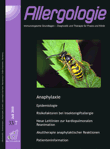
ALLERGOLOGIE
Scope & Guideline
Bridging the Gap Between Research and Clinical Practice
Introduction
Aims and Scopes
- Allergen Immunotherapy (AIT):
The journal consistently publishes research on allergen immunotherapy, discussing various methods, efficacy, and safety profiles of treatments for different allergens. - Diagnosis and Management of Allergies:
A significant portion of the content revolves around the diagnosis and management of various allergic conditions, including guidelines for practitioners. - Molecular and Component-Resolved Diagnostics:
Research focusing on the molecular aspects of allergies and the development of component-resolved diagnostics is a key area, reflecting advancements in precision medicine. - Atopic Conditions and Comorbidities:
The journal frequently addresses atopic conditions such as asthma, rhinitis, and dermatitis, emphasizing their interconnections and the impact of comorbidities. - Emerging Allergens and Environmental Factors:
There is a growing focus on new allergens, including those related to climate change and urbanization, as well as their implications for public health. - Regulatory and Legal Aspects of Allergy Treatments:
The journal also emphasizes the legal and regulatory frameworks guiding the development and approval of allergen products and therapies.
Trending and Emerging
- Biologics and Targeted Therapies:
There is a significant increase in research focused on biologics and targeted therapies for allergic conditions, particularly in the management of severe asthma and atopic dermatitis. - Digital Health and mHealth Applications:
The emergence of digital health solutions, including mobile health (mHealth) applications for allergy management, is a growing trend, indicating the integration of technology in patient care. - Microbiome and Allergy Interactions:
Research exploring the relationship between the microbiome and allergic diseases is gaining prominence, reflecting an interest in understanding the underlying mechanisms of allergy development. - Climate Change and Allergy Patterns:
An increasing number of studies are examining how climate change affects allergen distribution and sensitization patterns, highlighting the public health implications of environmental changes. - Personalized and Precision Medicine Approaches:
The journal is increasingly featuring articles that focus on personalized medicine approaches in allergy diagnosis and treatment, emphasizing the need for tailored therapies based on individual patient profiles.
Declining or Waning
- Occupational Allergies:
Although historically significant, research specifically focused on occupational allergies seems to be less frequently published, possibly due to a shift in focus towards more prevalent allergens and conditions. - Traditional and Non-Specific Allergy Treatments:
There is a noticeable decrease in articles discussing traditional or non-specific treatments for allergies, as the field moves towards more targeted and personalized therapies. - General Allergen Exposure Studies:
While general studies on allergen exposure were previously common, the journal is now trending towards more specific research that integrates molecular and individual patient data. - Classic Allergy Testing Methods:
The frequency of discussions surrounding traditional allergy testing methods, such as skin prick tests, appears to be waning as newer methodologies gain traction.
Similar Journals
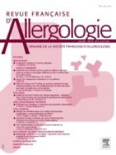
Revue Francaise d Allergologie
Bridging Clinical Practice and Academic Excellence in AllergologyThe Revue Francaise d'Allergologie, an esteemed publication in the field of Immunology and Allergy, is published by ELSEVIER MASSON, CORP OFF in France. This journal plays a pivotal role in disseminating significant findings and advancements in allergy research and immunotherapy, reflecting the latest trends and challenges in these rapidly evolving areas. As part of its commitment to scholarly rigor, the journal encompasses a wide range of topics pertinent to allergology, aiming to bridge the gap between clinical practice and academic research. Although currently not listed as open access, it provides critical insights essential for researchers, professionals, and students alike, ensuring the advancement of knowledge and therapeutic strategies in allergy and immunology. With its impact factor and positioning in the Q4 category, it serves as a valuable resource, aiding in the education and development of future leaders in the field. The Revue Francaise d'Allergologie continues to be a vital platform for the exchange of innovative ideas and findings from 2009 to the present.

Current Allergy & Clinical Immunology
Empowering professionals with cutting-edge research.Current Allergy & Clinical Immunology is a vital peer-reviewed journal published by the Allergy Society of South Africa, focused on advancing the field of immunology and allergy medicine. With an ISSN of 1609-3607, this journal offers crucial insights and research findings pertinent to the understanding and treatment of allergic conditions. Operating from South Africa, it features contributions from a diverse range of authors and professionals in the field. Published from 2008 to 2024, the journal plays an essential role in disseminating current knowledge, even as it holds a Q4 ranking in Immunology and Allergy and is positioned at the 4th percentile based on Scopus rankings. While not open access, it remains an important resource for researchers, practitioners, and students looking to stay informed on emerging trends and breakthroughs in allergy and clinical immunology.
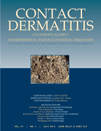
CONTACT DERMATITIS
Transforming Understanding of Skin ReactionsCONTACT DERMATITIS, published by WILEY, is a leading international journal focused on the vital field of dermatology, particularly examining the diagnosis, treatment, and management of contact dermatitis and related skin conditions. With origins dating back to 1975 and a planned convergence period extending to 2024, this esteemed journal serves as a crucial resource for researchers, clinicians, and healthcare professionals dedicated to advancing knowledge in dermatological practices. In the latest rankings, it has achieved a commendable Q2 classification in Dermatology and Q3 classification in Immunology and Allergy for 2023, underscoring its significance within these dynamic fields. Moreover, it holds a notable ranking of #29/142 in Medicine & Dermatology and #130/233 in Medicine & Immunology and Allergy according to Scopus metrics, placing it in the top tier of scholarly publications. While the journal operates on a subscription basis, its comprehensive reviews, original articles, and insightful research findings are invaluable for pushing the boundaries of current dermatological and immunological knowledge. By fostering a deeper understanding of the complexities of skin reactions and their implications, CONTACT DERMATITIS plays a vital role in connecting research with clinical practice, making it an essential read for anyone engaged in the field.

Postepy Dermatologii i Alergologii
Exploring the forefront of skin and immune health.Postepy Dermatologii i Alergologii is a distinguished Open Access journal published by TERMEDIA PUBLISHING HOUSE LTD, dedicated to advancing the fields of Dermatology and Immunology and Allergy. Since its inception in 2003, this journal has served as a vital platform for researchers and practitioners alike, promoting knowledge sharing and collaboration in Poland and beyond. With a current impact ranking placing it in the Q3 quartile for both Dermatology and Immunology and Allergy categories, it plays a significant role in contributing to academic discourse within these fields. The journal is indexed in Scopus, with respectable rankings reflecting its relevance and quality—#65/142 in Dermatology and #163/233 in Immunology and Allergy. Researchers are encouraged to explore a vast array of innovative studies and reviews, making it an essential resource for anyone seeking to stay at the forefront of dermatological and allergic research. For those interested in discovering groundbreaking findings and contributing to the ongoing dialogue in these disciplines, Postepy Dermatologii i Alergologii offers not only free accessibility but also a commitment to scholarly excellence.

Egyptian Journal of Pediatric Allergy and Immunology
Exploring breakthroughs in allergy and immunology for children.Welcome to the Egyptian Journal of Pediatric Allergy and Immunology, a leading academic platform dedicated to the advancement of knowledge in the field of pediatric allergy and immunology. Published by the prestigious Egyptian Society of Pediatric Allergy & Immunology, this journal aims to address the pressing challenges and breakthroughs in the diagnosis, treatment, and management of allergic diseases in children. As a crucial resource for researchers, healthcare professionals, and students, it focuses on disseminating high-quality, peer-reviewed articles that contribute to the global understanding of allergic conditions and immunological responses in pediatric populations. Although the journal is currently not an Open Access publication, it provides a valuable gateway to research findings that can shape clinical practice and influence future investigations. With an emphasis on contributing to improved healthcare outcomes for children suffering from allergy and immunology disorders, the Egyptian Journal of Pediatric Allergy and Immunology stands out as an essential reference in the field.
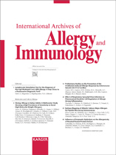
INTERNATIONAL ARCHIVES OF ALLERGY AND IMMUNOLOGY
Elevating Allergy and Immunology Research to New Heights.INTERNATIONAL ARCHIVES OF ALLERGY AND IMMUNOLOGY, published by KARGER, is a distinguished journal dedicated to advancing the field of immunology and allergy research. With an ISSN of 1018-2438 and an E-ISSN of 1423-0097, this journal has been a vital resource since its inception in 1950, continuing to publish influential articles through 2024. Hailing from Switzerland, it holds an important position within the Q3 category in Immunology and Allergy and Q2 in miscellaneous Medicine, reflecting its growing impact in the scientific community. The Scopus rankings showcase its relevance, with a 52nd percentile in Immunology and Allergy and 45th in Immunology and Microbiology. Although not an open-access journal, it plays a critical role in disseminating significant findings and innovations in the understanding of allergic diseases and immunological responses. The INTERNATIONAL ARCHIVES OF ALLERGY AND IMMUNOLOGY is essential for researchers, clinicians, and students eager to stay at the forefront of allergy and immunology developments.
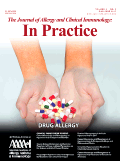
Journal of Allergy and Clinical Immunology-In Practice
Exploring the forefront of allergy and immunology.The Journal of Allergy and Clinical Immunology-In Practice, published by ELSEVIER, stands as a leading platform in the field of allergy and immunology, specifically tailored for practitioners and researchers. With an impressive 2023 Q1 ranking in both the Immunology and Allergy categories, this journal demonstrates a significant impact within the academic community, evidenced by its Scopus rank #41 out of 233 and an impressive percentile rank of 82. The journal focuses on providing advanced studies, clinical findings, and innovative treatment methodologies that address current challenges in allergy and immunology, making it a vital resource for professionals in these fields. With a comprehensive coverage of relevant topics from 2013 to 2024, the journal continues to evolve alongside emerging trends and developments in clinical practice, fostering an environment conducive to scholarly research and application. Although it currently does not offer open access, authors and readers can access a wealth of information and contribute to ongoing dialogues through its robust publication platform.
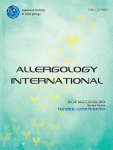
ALLERGOLOGY INTERNATIONAL
Elevating standards in immunology research.ALLERGOLOGY INTERNATIONAL is a prestigious, peer-reviewed journal dedicated to advancing the field of immunology and allergy research. Published by the Japanese Society of Allergology, this Open Access journal has been democratizing knowledge since 1996, providing a platform for the latest findings and clinical practices in the management of allergic diseases. Its impressive Q1 ranking in both Immunology and Allergy** and **Medicine (miscellaneous)** categories in 2023 highlights its significance in the global scientific community, with a commendable Scopus ranking of #31 out of 233 in the field of immunology. The journal's focus on innovative research, comprehensive reviews, and case studies ensures that it remains a vital resource for researchers, healthcare professionals, and students alike. Situated in Tokyo, Japan, it continues to bridge gaps in allergy-related health information and foster international collaboration among scholars.
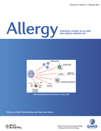
ALLERGY
Pioneering Research in Allergy and Immunological Health.ALLERGY is a leading international journal published by WILEY, dedicated to advancing the understanding of allergic diseases and immunology. With an ISSN of 0105-4538 and an E-ISSN of 1398-9995, this esteemed journal has been at the forefront of the field since its inception in 1948 and continues to publish high-quality research up until 2024. Positioned in the Q1 category for both Immunology and Allergy, ALLERGY ranks impressively within the top percentiles of its categories, underscoring its significant impact, as reflected in its Scopus rankings (#11 out of 233 in Immunology and Allergy, and #14 out of 236 in Immunology and Microbiology). Researchers and practitioners accessing this journal can expect a rigorous selection of peer-reviewed articles that address current challenges, innovative therapies, and advancements in the immunological sciences. Although it is not an open-access journal, ALLERGY remains vital for academics, healthcare professionals, and students alike, fostering a deeper understanding of the mechanisms and treatments associated with allergies.
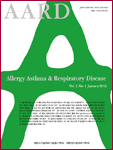
Allergy Asthma & Respiratory Disease
Bridging science and practice in respiratory medicine.Allergy Asthma & Respiratory Disease is a pioneering journal dedicated to advancing research and clinical practice in the fields of allergy, asthma, and related respiratory diseases. Published by the esteemed Korean Academy of Asthma Allergy & Clinical Immunology, this journal aims to disseminate high-quality, peer-reviewed articles that contribute to the understanding, diagnosis, and treatment of these prevalent health issues. Although it operates under a subscription model, it maintains a robust reputation for being a pivotal resource in respiratory health, attracting authors and researchers worldwide. The journal emphasizes interdisciplinary approaches and encourages submissions that span from molecular biology to public health perspectives, making it a vital platform for professionals, researchers, and students eager to deepen their knowledge in respiratory medicine. With a commitment to fostering academic discourse in South Korea and beyond, Allergy Asthma & Respiratory Disease is positioned as a significant contributor to the global conversation on respiratory health.